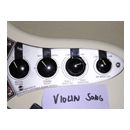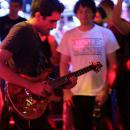Hola;
No se trata de un rumor sino de una entrevista con el ingeniero de grabacion.
Lo que entiendo es que puso los monitores bajitos en la sala de control y Isaak cantando por el Sanken. Esto me lo creo porque hacer una toma de esa voz por auriculares es muy complicado; en el mercado anglosajon lo que se valora es la precision muy por encima de la potencia (no como por estos lares que un anormal pegando gritos con la nariz es un gran cantante).
Es mas facil conseguir esa precision si te oyes tu voz al natural porque la puedes modular en tiempo real.
Lo que no me cuadra es que sonasen por los monitores toda la plantilla instrumental porque se cuela por el micro.
Je, sobre polemizar el articulo tiene caña porque resulta que esa cancion se grabo con loops, midis y samples de otras grabaciones antiguas (se me cae el cielo encima al leer cosas asi.
A ver si me cabe el original en ingles;
Alguien escribió:
“Wicked Game” sounds so organic, so present, and so natural that even studio cynics may be surprised to learn it was largely a studio creation, an early example of what can be achieved with samples, loops, and a relentless, perfectionist vision.
Bay Area-based engineer Mark Needham has worked with Isaak on almost all of his records, as well as on the music for Showtime's The Chris Isaak Show. The making of “Wicked Game” was particularly fresh in his mind when we spoke, as he and Isaak had recently teamed to recut the track for its use in a Jaguar car commercial.
According to Needham, “Game” had been kicking around for several years before the definitive version was put together. Many incarnations had made it to tape, but none felt quite right. “That song had a long life,” he deadpans, “a real long life. Chris had played it with the band many times, and we'd recorded a bunch of different versions, with different arrangements. But we never thought that the drum track had the metronomic feel that we really wanted. That was something it really needed, especially in the verses, to convey the song.”
Isaak again recorded “Game” with Silvertone among some tracks cut in 1988 at Berkeley, Calif.,-based Fantasy Studios. The team then adjourned to the now-defunct Dave Wellhausen Studios in San Francisco's Sunset District, where they settled in and began cutting and pasting. Kenney Dale Johnson's drum tracks were sampled into an Akai DD1000 sampler (Needham calls it an “ancient forerunner to Pro Tools”); then they began making loops and reinventing the groove.
“I'd been doing stuff with the early Eventide H3000s and other boxes,” Needham recalls. “Sampling was still in a primitive state, but we were making loops using samples and triggering them off MIDI. For ‘Wicked Game,’ the samples came from various 24-track outtake versions that we were never really happy with. We'd take six or seven different brush patterns and make loop patterns we could trigger off a MIDI note.”
Rowland Salley's bass guitar tracks were also compiled from previously recorded versions of the song that were sampled. After samples were loaded into the Akai, MIDI tracks were built with Mark of the Unicorn (now MOTU) Performer software. Finished loops were dumped back to an MCI JH-24 analog 24-track on Ampex 456 tape at +6 level. Johnson then came back in to overdub cymbals. “As I remember,” remarks Needham, “we gave him a fake kick pedal so that he could feel like he was actually hitting something a little hard to play along with. We were trying to keep the live feel so it didn't sound programmed, but it had that precision and regularity, which really helps make the verses work.”
Outboard preamps, direct to tape, were preferred for the overdubs, and Wellhausen's Soundcraft board was used only for monitoring. “We had four [Neve] 1073s that I'd gotten Chris to buy early on,” Needham says. “We also had some Massenburg preamps that we'd rented from Stephen Jarvis.”
Guitars are key to the song. Isaak himself played two acoustics: one standard and one in a Nashville-style high-strung tuning he'd picked up from Night Ranger's Jeff Watson. The haunting lead was by Silvertone's guitarist at the time, James Calvin Wilsey; that, too, was painstakingly crafted. Although Wilsey's melody had been written and played with the live tracks, the version that appears on the record was put together from numerous tracks overdubbed over a period of a couple of weeks, then comped and refined piece by piece.
One of the subtly cool sounds on the track is a MIDI'd string sound triggered by the lead guitar. “Jimmy's Strat had a custom MIDI setup,” notes Needham, “and he played the underlying string pad that goes along with the guitar. [Keyboardist] Frank Martin also played a little sustaining part along with it. It's the only keyboard part on the song; you hear it like a little drone.”
Another striking effect on Wilsey's guitar, which was played through a 1964 Fender Deluxe amp miked with a Shure SM57, is a long, quarter-note, triplet delay that swells up at the end of certain notes. To create it, his mono guitar track was sent to a TC Electronic 2290 for pre-delay, then fed to an Eventide H3000 stereo Rich Chorus program. The effect is that the mono guitar hit swells up into the delay, then spreads out into the stereo chorus to create a kind of pad. Needham rode the effect up at each spot by hand, then automated it and printed onto a track of the MCI.
The major hook of the song is the interplay between Wilsey's guitar and Isaak's vocal. Needham recalls a Sanken C-41 mic on the vocal, through a Massenburg preamp/EQ, and an English EAR (Esoteric Audio Research) compressor. Isaak got that really big vocal sound singing in the tiny control room using speakers instead of headphones.
“He was singing to the speakers, really soft,” Needham explains. “If you listen really carefully, there's a change in the cymbal sound every time the vocal comes in, because you're hearing the bleed of the cymbals through the monitors into the vocal mic.”
Reverb on the vocal was a Lexicon 480 with a modified version of the Snare Plate program, which Needham frequently used on Isaak. “I'd take the pre-delay down, set the room size at 35 meters and the overall delay probably about two seconds,” he says. “I'd also take the high frequency off down to 5 or 6k. As a general rule, I'd be sending to the chorus from a separate fader [a split of the vocal] running first to a pre-delay, then to the 480, which I'd ride up at the end of the line.”
The almost subliminal backgrounds that whisper, “It's only it's only gonna break your heart,” were a fortuitous accident. According to Needham, “The singers were friends of Chris', not professional background singers. We sampled them also and flew them in manually from either an H3000 or a Publison [Infernal Machine] — I can't remember. They had a really nice, unslick kind of sound, which was what we wanted, but there were also some pitch problems. It was before Auto-Tune of course, so we just kept them really soft in the track. It came across as sort of whispers, where you almost can't hear what they're singing.”
Mixing was at the also now-defunct Amigo Studios in Hollywood, on an early Neve V console with Necam automation, to ¼-inch Ampex 456 tape also at +6. A last hook added during mixing was the way that Isaak's “cry” fades off into echo near the end of the song. “There was that long, quarter-note, triplet delay that kind of goes off into infinity,” Needham remembers, “that I used on high sustained notes. And then I used the Sound Hoarder program on the Publison as a sampler to offset his note a little bit in time. I moved it a little further back so that there were two tracks of it and we could crossfade it up, make it go really long and then off into the echoed delay.”
So there you go. All of you who thought Isaak was merely a rockabilly purist, well, he's much more complicated than that. The art of the “Wicked Game” saga was making such a laborious process sound so completely natural, doing whatever it takes to deliver the full potential of a song. Luckily, the painstaking process that created the original wasn't needed in the recreation for Jaguar. “Yeah,” laughs Needham, “Pro Tools made it a lot easier to do it this time around.”







